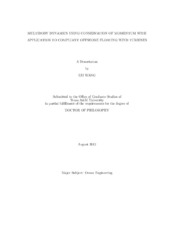| dc.description.abstract | Environmental, aesthetic and political pressures continue to push for siting off-shore wind turbines beyond sight of land, where waters tend to be deeper, and use of floating structures is likely to be considered. Savings could potentially be realized by reducing hull size, which would allow more compliance with the wind thrust force in the pitch direction. On the other hand, these structures with large-amplitude motions will make dynamic analysis both more challenging and more critical. Prior to the present work, there were no existing dynamic simulation tools specifically intended for compliant wind turbine design.
Development and application of a new computational method underlying a new time-domain simulation tool is presented in this dissertation. The compliant floating wind turbine system is considered as a multibody system including tower, nacelle, rotor and other moving parts. Euler's equations of motion are first applied to the compliant design to investigate the large-amplitude motions. Then, a new formulation of multibody dynamics is developed through application of the conservation of both linear momentum and angular momentum to the entire system directly. A base body is prescribed within the compliant wind turbine system, and the equations of motion (EOMs) of the system are projected into the coordinate system associated with this body. Only six basic EOMs of the system are required to capture 6 unknown degrees of freedom (DOFs) of the base body when mechanical DOFs between contiguous bodies are prescribed. The 6 x 6 mass matrix is actually composed of two decoupled 3 x 3 mass matrices for translation and rotation, respectively. Each element within the matrix includes the inertial effects of all bodies. This condensation decreases the coupling between elements in the mass matrix, and so minimizes the computational demand. The simulation results are verified by critical comparison with those of the popular wind turbine dynamics software FAST.
The new formulation is generalized to form the momentum cloud method (M- CM), which is particularly well suited to the serial mechanical N-body systems connected by revolute joints with prescribed relative rotation. The MCM is then expanded to multibody systems with more complicated joints and connection types. | en |


